Australian firm, Monochrome Asset Management, has applied for a spot bitcoin exchange traded fund (ETF) with the global listing exchange, Cboe Australia, it announced on Friday.
Grayscale Bitcoin ETF Sees Drastic 60% Drop In Outflows, Why This Is Important
The outflows from the Grayscale Bitcoin ETF rocked the market hard last week, leading to a dramatic decline in the BTC price. However, with the new week, there has been a change in direction as investors begin to get bullish on Bitcoin once more. As a result, the outflows from the Grayscale ETF have slowed down, reaching one of its lowest points for the month.
Grayscale Bitcoin ETF Outflows Drop 60%
Grayscale outflows ramped up last week, spearheading what would turn out to be a full week of outflows from Spot Bitcoin ETFs for the first time ever. The outflows rose rapidly over the week, even moving into the new week. However, inflows into Spot Bitcoin ETFs have been on the rise, which have overshadowed the outflows from GBTC.
Despite the outflows from the GBTC continuing, it has begun to spin into a more positive narrative as the number of BTC flowing out of the fund is declining fast. To put this in perspective, data shows there was 299.8 BTC moved out of the fund on Wednesday, March 27, and on Thursday, March, 20204, this figure dropped to 104.9 BTC, representing a 60% drop.
This marks the second day with the lowest outflows from the Grayscale Bitcoin ETF right behind the March 12 outflows of 79 BTC. It also points to a decline in the volume of outflows as investors start to level out and find their footing elsewhere.
Nevertheless, the GBTC has remained the loser of the Spot Bitcoin ETF race, nursing a full month of outflows so far. Since the ETFs were first approved in January until now, there has been more than $14.6 billion moved out of the fund, which accounts for around 50% of its total balance. These BTC have presumably found a home in other Spot ETF funds which have been seeing massive inflows.
Unlike last week, inflows have also dominated Spot Bitcoin ETFs this week. Total inflows for the week crossed above $800 million, bringing the total Assets Under Management (AuM) to almost $57 billion in less than three months.
Why This Could Trigger A BTC Price Rally
The last time that GBTC outflows saw a slowdown after rising for about a week, it triggered a response from the Bitcoin price in the form of a rally. Inflows also continued to dominate for the next couple of weeks and during this time, the BTC price enjoyed a long stretch of recovery. It went from $40,000 to over $70,000 in the space of two months.
If this trend repeats itself this time around, then another massive BTC price rally could be around the corner. A similar price increase would also put Bitcoin right above $100,000 in the next few months. In this case, the uptrend would be far from over.
At the time of writing, Bitcoin is still struggling to break $70,000 after a 1% drop in the last day.
The Bulls Are Back: Spot Bitcoin Inflows Surge With New Records
Bitcoin bulls look to be firmly back in the driver’s seat following weeks of seeing BTC suffer a bearish sentiment with its price dips. The current bullish outlook for the flagship crypto is evident in the fact that the Spot Bitcoin ETFs are again recording an impressive amount of inflows.
Spot Bitcoin ETFs Record $243 Million In Inflows
Farside Investors revealed in an X (formerly Twitter) post that the Spot Bitcoin ETFs recorded $243 million in inflows on March 27. This record was primarily thanks to BlackRock’s iShares Bitcoin Trust (IBIT) and the ARK 21Shares’ Bitcoin ETF (ARKB), which saw individual inflows of $323.8 million and $200.7 million, respectively.
These inflows were enough to overshadow the $299.8 million that Grayscale’s Bitcoin ETF GBTC recorded on the day. Meanwhile, this marks the third consecutive day that these Spot Bitcoin ETFs have recorded net inflows, having seen net outflows throughout last week. These funds recorded an inflow of $418 million and $15.4 million on March 26 and 25, respectively.
This is undoubtedly a welcome development for the crypto community, considering that analysts at JPMorgan already predicted that the wave of profit-taking from the BTC ETFs could last until Halving. Therefore, seeing sustained inflows into these ETFs could mean that the sentiment among these ETF investors has changed.
Irrespective of the current outlook for these ETFs, there is reason to be confident about their future trajectory and how much funds could still flow into the Bitcoin ecosystem. Matt Hougan, the Chief Investment Officer (CIO) at Bitwise, recently suggested that the demand for these Bitcoin ETFs is far from its peak. That means that these funds could still witness an astonishing amount of inflows.
BTC Still Primed For More Upside Move Before Halving
The current bullish sentiment towards BTC suggests that the flagship crypto move could see further moves to the upside before the Halving event in mid-April. Besides the Spot Bitcoin ETFs, which are back to recording net inflows, other fundamentals hint at a price surge for BTC soon enough.
NewsBTC recently reported that the supply of BTC on centralized exchanges (CEX) has been declining lately, which means that the sell pressure for the crypto token has reduced significantly. With Bitcoin whales cooling off on selling, that leaves room for BTC to embark on an upward trend.
At the time of writing, BTC is trading at around $70,300, up in the last 24 hours according to data from CoinMarketCap.
BlackRock’s Fink Says an Ether ETF Is Possible Even if ETH Is a Security
BlackRock CEO Larry Fink isn’t worried about the U.S. Securities and Exchange classifying Ethereum’s ether as a security.
U.S Has its Eleventh Spot Bitcoin ETF After Hashdex Fund Conversion
Trading under the ticker DEFI, asset manager Hashdex’s Bitcoin Futures ETF – which had been trading as a futures-based fund on the New York Stock Exchange since 2022 – was renamed and converted into the Hashdex Bitcoin ETF and now operates as a spot bitcoin fund.
Hong Kong-Based Asset Manager VSFG and Value Partners Apply for Spot Bitcoin ETF
Asset Manager VSFG, together with its partners, Value Partners, have applied for a spot-bitcoin exchange-traded fund (ETF) with Hong Kong’s Securities and Futures Commission (SFC), its Head of Investment & Products Brian Chan told CoinDesk on Wednesday.
Hong Kong Likely To Allow In-Kind Creations for Spot Bitcoin ETFs: Bloomberg
Hong Kong’s financial regulator, the Hong Kong’s Securities and Futures Commission (SFC), is likely to allow in-kind creations and redemptions for spot bitcoin ETFs in the second quarter of this year, according to a report from Bloomberg Intelligence.
Bitcoin ETF Netflows May Experience Rebound If This Price Is Attained, Analyst Explains
In line with the decline in Bitcoin’s price, the spot Bitcoin ETF market has appeared rather gloomy in recent days. According to data from analytics firm BitMEX Research, these BTC ETFs have recorded a negative netflow for the last four trading sessions.
This situation has been marked by large levels of Grayscale’s GBTC outflows and the record low inflows for the other ETFs, mainly the market leaders BlackRock’s IBIT and Fidelity’s FBTC. However, amidst these persistent declining netflows, Ki Young Ju, a prominent analyst and Chief Executive Officer at Cryptoquant, has predicted a possible resurgence in the spot Bitcoin ETF market.
Analyst Pinpoints $56,000 Level As Critical To Bitcoin ETF Recovery
In a post on X on March 22, Ki Young Ju shared that a rise in spot Bitcoin ETFs netflows could occur even as the BTC price decline continues. Using data from the historical netflow trends, the analyst noted that demand for Bitcoin ETFs usually kicks in when the cryptocurrency traces to certain support levels.
Young Ju stated that, in particular, new BTC whales, especially ETF buyers, have shown to have a $56,000 on-chain cost basis. This suggests that the new significant holders of Bitcoin, particularly those invested in ETFs, usually purchased Bitcoin at an average price of $56,000. Following this trend, the crypto quant boss believes the spot Bitcoin ETF market could experience massive inflows if BTC reached the specified price level.
#Bitcoin spot ETF netflows are slowing.
Demand may rebound if the $BTC price approaches critical support levels.
New whales, mainly ETF buyers, have a $56K on-chain cost basis. Corrections typically entail a max drawdown of around 30% in bull markets, with a max pain of $51K. pic.twitter.com/vZCG4F0Gh5
— Ki Young Ju (@ki_young_ju) March 22, 2024
For now, Bitcoin’s price has oscillated between $62,000 and $68,000, as seen in the last week. However, Young Ju believes that such a descent is quite feasible as price corrections usually see a maximum decline of 30%. Using BTC’s most recent high of $73,750, the analyst predicts the asset price could still trade as low as $51,000.
BTC Price Overview
At press time, Bitcoin continues to trade at $64,065.74, representing a decline of 3.73% and 7.17% in the last one and seven days. Meanwhile, the asset’s daily trading volume is down 3.53% and valued at $39.62 billion.
Following historical trends of the bull cycle, it is possible that BTC may have reached its price peak leading up to the halving event in April. If that is the case, Bitcoin may likely not return to previous high price levels soon and could experience further price drops in the coming weeks.
Bitcoin Market Cap Hints at Potential Price Surge After Retesting 2021 Highs
A crypto analyst on X is confident that Bitcoin has bottomed and is poised for major gains in the sessions ahead. Interestingly, the bullish outlook hinges on the Bitcoin market cap retesting all-time highs at press time.
Will BTC Rally? Market Dynamics Changing
So far, the Bitcoin price is around 2021 highs in USD terms but recently broke all-time highs, peaking at around $73,800. This fluctuation is also reflected in its market cap. It currently stands at $1.25 trillion, down 5% in the past 24 hours.
Notably, it is at the same price level as in 2021, when Bitcoin prices peaked, recording new all-time highs.
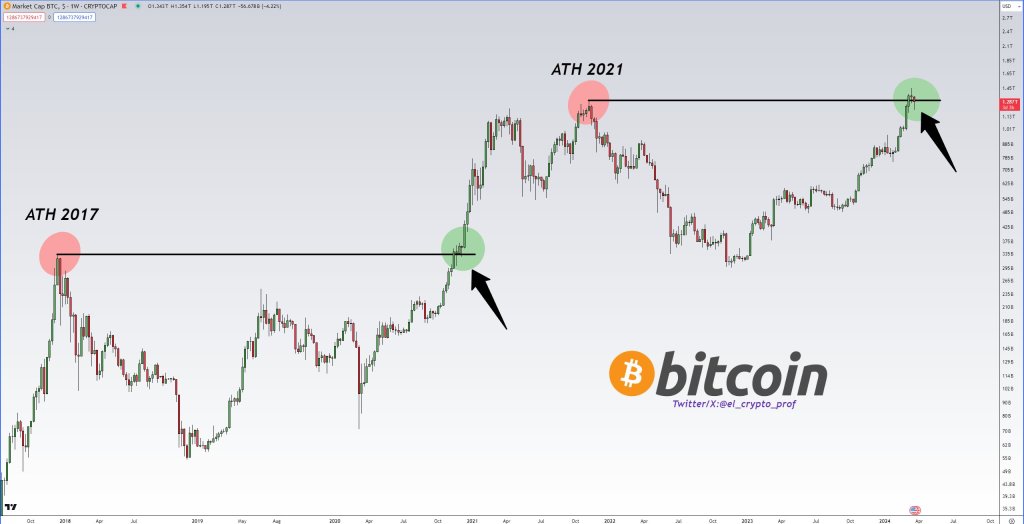
While optimism abounds and the trader expects more sharp price expansions in the days ahead, it is not immediately clear whether the coin will rip higher, aligning with this forecast. Bitcoin is volatile and has remained so despite changing market dynamics.
At the same time, unlike in the past, Bitcoin prices are driven not only by retail forces but by institutions. These institutions are regulated by the United States Securities and Exchange Commission (SEC), which also approved the spot Bitcoin exchange-traded fund (ETF).
This Bitcoin derivative product has been the primary driving force in the past ten weeks. This is from looking at how prices have evolved since its approval in mid-January 2024.
However, since BlackRock and Fidelity are regulated by the United States SEC, unlike retailers, they cannot act as they wish. Considering the millions and billions of dollars at play, their comments or assessments on the coin, now and in the future, can greatly impact sentiment.
Sentiment Is Dented, BTC Facing Headwinds
Sentiment has been dented when writing. Even with the United States Federal Reserve (Fed) ‘s decision to hold rates at 5.5%, the highest in 2023, lifting prices, there has been no solid follow-through in price action. The coin remains steady below $70,000.
Whether prices will rally over the weekend remains to be seen. However, for now, there are some headwinds to consider.
First, there has been a slowdown in inflows to spot BTC ETFs. At the same time, outflows from the Grayscale Bitcoin Trust (GBTC) have increased. Second, after rallying sharply from October 2023, a cool-off before halving might see the coin trend lower.
Bitcoin Price Reclaims $66,000 Despite 4-Day ETF Outflow Streak
Despite a continuous four-day streak of net outflows from Bitcoin spot exchange-traded funds (ETFs) totaling $93.85 million, the Bitcoin price has impressively climbed to reclaim the $66,000 mark. According to data from Farside Investors, Grayscale ETF GBTC experienced a significant outflow yesterday, with a single-day net outflow of $358 million, culminating in a historical net outflow of $13.63 billion for GBTC alone.
In stark contrast, the BlackRock Bitcoin spot ETF (IBIT) witnessed a considerable net inflow of $233 million yesterday, raising IBIT’s total net inflow to $13.32 billion. This is slightly below the average for BlackRock, which has seen $271.9 million in inflows since its launch on January 11.
Other ETFs have not fared as well in recent days. Fidelity’s FBTC, the second-largest ETF, has thus far achieved an average daily inflow of $141.5 million, but experienced a disappointing $2.5 million in inflows yesterday.
The third-largest, Ark Invest’s spot Bitcoin ETF, has seen average inflows of $40.9 million to date, with yesterday’s inflows at just $2.0 million. Bitwise’s BITB, ranking fourth, has accumulated $30.7 million on average, with a modest $12 million in inflows yesterday.
Across the board, all spot Bitcoin ETFs, including GBTC, have recorded an average of approximately $230 million in daily inflows since January 11.
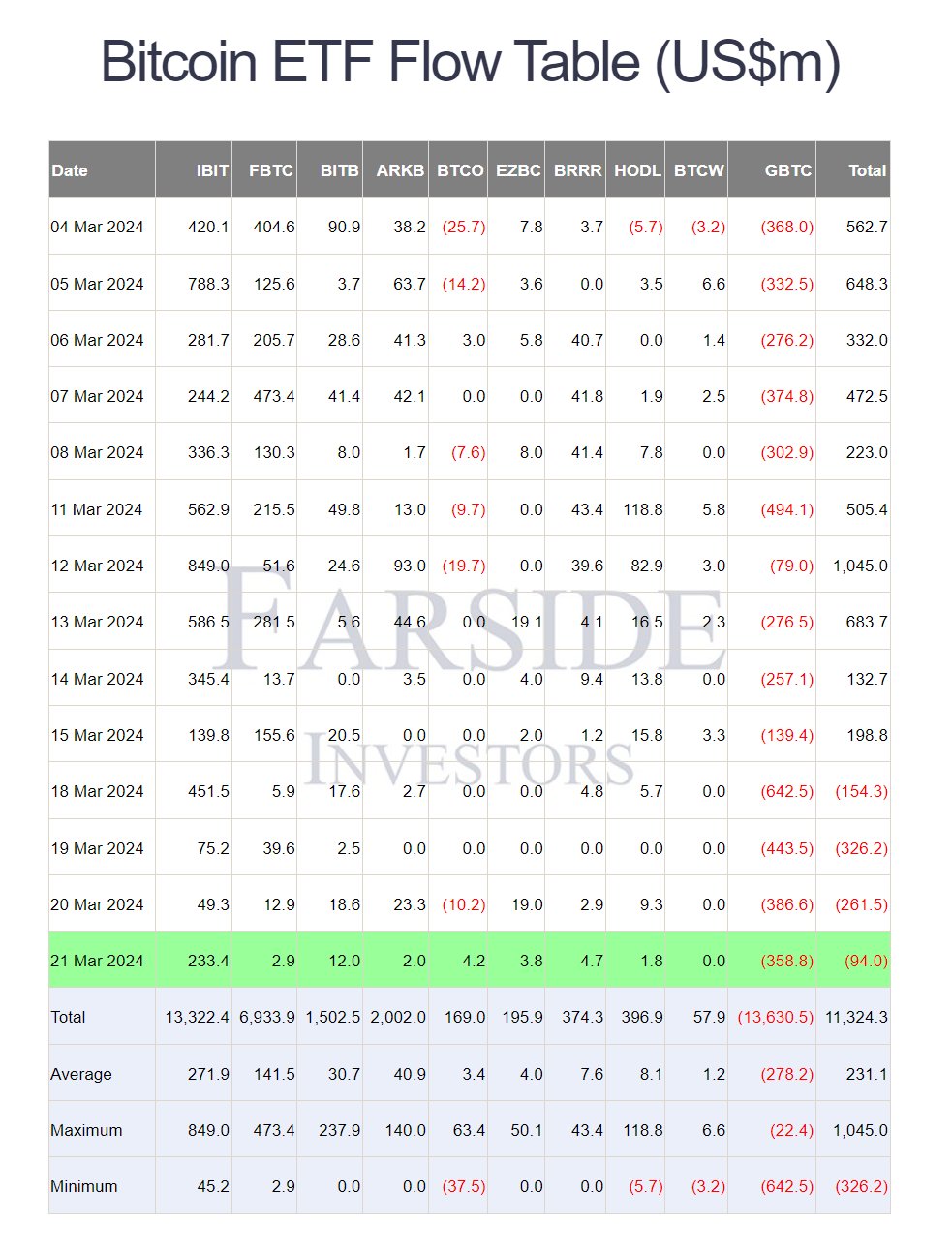
Bitcoin Price Stagnates: Reason To Worry?
CryptoQuant CEO Ki Young Ju provided insights on the situation via X, stating, “Bitcoin spot ETF netflows are slowing. Demand may rebound if the BTC price approaches critical support levels. New whales, mainly ETF buyers, have a $56K on-chain cost basis. Corrections typically entail a max drawdown of around 30% in bull markets, with a max pain of $51K.”
Crypto analyst WhalePanda highlighted the trend, noting, “Yesterday’s ETF flows: Another negative day, that’s 4 in a row […] Honestly surprised by how big the outflows are from GBTC. Another $358.8 million and that makes a total of $1.83 billion in just 4 days.” WhalePanda also touched on Genesis’ role, suggesting the company’s “in-kind” sale of GBTC shares for BTC might explain the large outflows without corresponding market dumps.
Thomas Fahrer, founder of Apollo, offered a bullish perspective, “I know it is forbidden to post anything bullish on #Bitcoin ETFs right now, but I’m gonna do it anyway. GBTC selling is temporary. Financial advisors and institutions have barely begun buying. $100 BILLION inflows are coming next 1-2 years. Patience.”
Charles Edwards, founder of Capriole Investments, commented on the Grayscale situation, “Grayscale Bitcoin ETF holdings falling off a cliff. Down 50%, or about $20B at current BTC price. We must be days/weeks away from them slashing fees to stop the bleeding. Blackrock holdings expected to overtake Grayscale before the Halving!”
Although the last few days have been rather disappointing, it is worth noting that the outflows are coming (almost) exclusively from Grayscale’s GBTC, while other investors are holding on tight to their Bitcoin investments. This means that it is only a matter of time before Grayscale’s outflows stop, and even small inflows from the other ETFs make a big impact (without the outflows).
At press time, BTC traded $66,203.
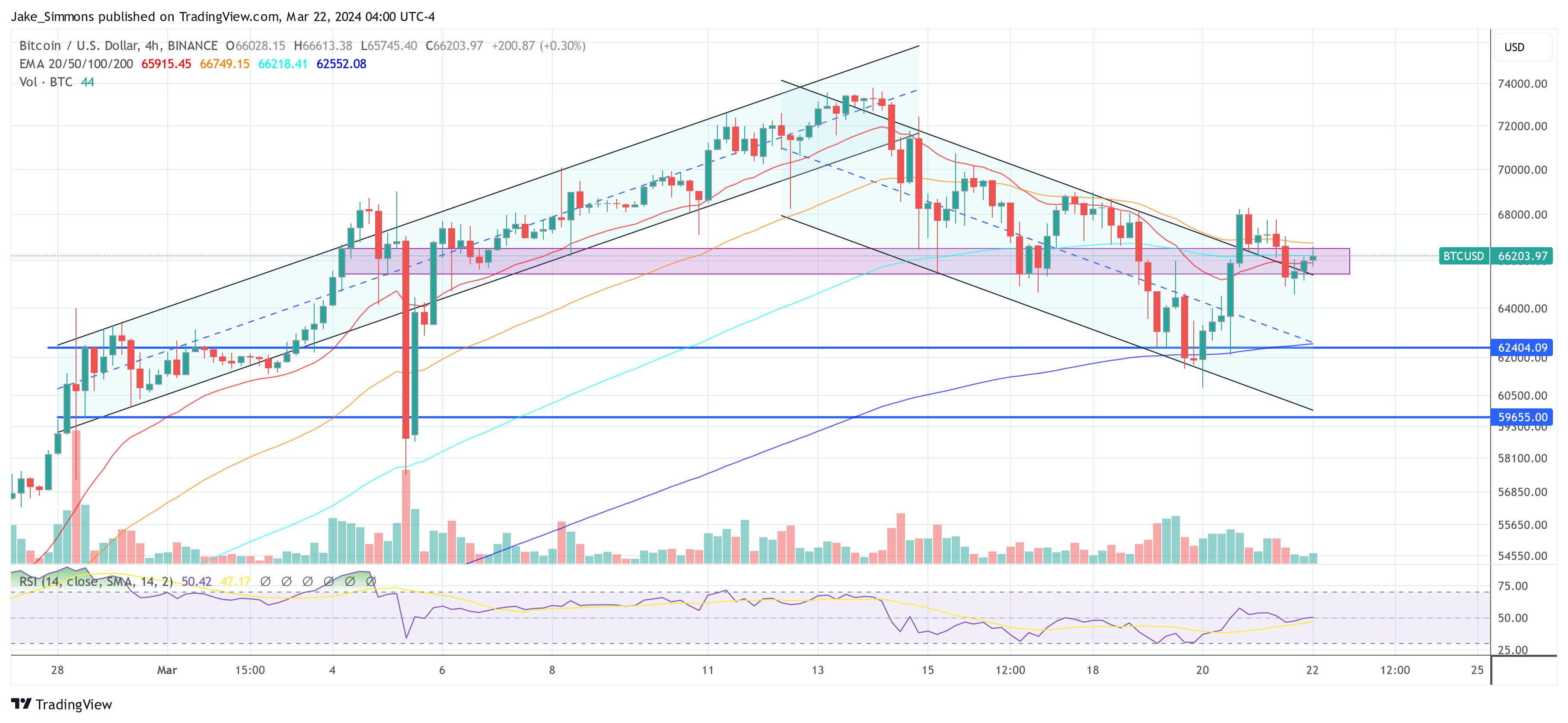
US Spot Bitcoin ETFs Experience Record Outflows, Losing $740 Million In Three Days
The 10 spot Bitcoin ETFs experienced their biggest three-day outflow since their debut in January, as reported by Bloomberg. This shift in investor sentiment comes after heightened interest that propelled the largest cryptocurrency in the market to a record high of $73,700.
Bitcoin ETFs See Record Outflows
Between Monday and Wednesday, a net total of $742 million exited the Bitcoin ETFs, reflecting outflows from the Grayscale Bitcoin Trust (GBTC) and a moderation in subscriptions for similar offerings from prominent firms like BlackRock (IBIT) and Fidelity Investments (FBTC).
According to Bloomberg ETF expert Eric Balchunas, the Grayscale Bitcoin Trust has experienced a notable outflow surge. This recent development indicates a “second wind” of investor withdrawals, with a substantial $1.4 billion leaving the trust just this week.
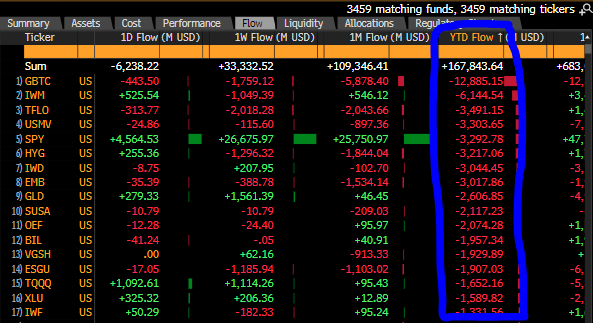
Notably, these withdrawals have surpassed all other ETFs in year-to-date outflows and set a new record for cumulative outflows in ETF history, as shown in the chart above.
Nevertheless, GBTC continues to hold a prominent position in terms of revenue generation. It currently ranks third out of the 3,400 ETFs available, demonstrating its continued financial success.
Despite the recent outflows, the overall performance of these funds remains noteworthy, with net inflows of $11.4 billion recorded since their launch, according to data compiled by Bloomberg. This signifies one of the most successful debuts for an ETF category.
Crypto Analyst Predicts “Massive Bounce” For BTC
Bitcoin experienced a significant surge of over 5% in the United States on Wednesday, propelled by signals from the Federal Reserve (Fed) hinting at potential interest-rate cuts.
However, the Asian market painted a different picture on Thursday, with Bitcoin losing momentum compared to continued gains in global stocks and gold. According to Bloomberg, the news of outflows from Bitcoin ETFs permeated markets, contributing to the contrasting performance.
Nonetheless, renowned crypto analyst Michael van de Poppe shared a bold prediction on social media platform X (formerly Twitter). In his post, he expressed optimism about a “massive bounce” for Bitcoin, suggesting the potential for a continuation of its upward trajectory.
Van de Poppe also predicted that Bitcoin could consolidate in the near term before embarking on another rally towards the all-time high it reached before the halving event, which is expected to begin sometime in April.
Currently, BTC is trading at $66,200, reflecting a 4% increase in the past 24 hours despite ongoing outflows in the ETF market. Over longer time frames, Bitcoin has shown consistent gains, with a 27% increase over the past thirty days and an impressive 136% gain year-to-date.
Featured image from Shutterstock, chart from TradingView.com
Bitcoin Faces One Major Hindrance To Reaching New $75,000 All-Time High
Bitcoin is still struggling to reclaim its all-time high even after staging an impressive recovery in the last day. The bounce up from $60,000 to $68,000 has no doubt reignited confidence in the market, but the cryptocurrency continues to face some challenges in its bid for a new all-time high.
Outflows Continue To Rock Bitcoin ETFs
Over the last few months, Spot Bitcoin ETFs have done very well when it comes to inflows, hitting record after record. This saw issues such as BlackRock garner a large number of coins in a short time, which contributed to the Bitcoin run to new all-time highs.
However, as the market gets used to the Spot Bitcoin ETFs being a part of daily investing, outflows have begun to rise. Mainly, these outflows have been from the Grayscale Spot Bitcoin ETF as investors flee from the fund due to their high fees. The same was the case back in January which triggered a crash in the market.
In the last few days, outflows have been dominating the ETF net flows. Data from Coinglass shows that net flows first turned negative at the start of the week on March 18, with $154.3 million flowing out of the funds. The next day, March 19, another $326.2 million left the funds, leading to higher negative flows than the previous day. Then, on March 20, net flows were negative once more, with $261.5 million leaving the funds.
This trend marks the first time since January that Spot Bitcoin ETFs have seen three consecutive days of outflows, which is in stark contrast to the previous week, which saw daily inflows hit a new all-time high of $1.04 billion on March 12.
BTC Price Buckles Under Sell Pressure
The sell pressure Bitcoin is shouldering right now is similar to the one seen in January right after the United States Securities and Exchange Commission (SEC) had given the green light to Spot Bitcoin ETFs for trading. The BTC price also suffered crashes during this time, dropping as low as $38,000.
However, the Bitcoin price had begun to pick up right after the Grayscale outflows slowed down, giving demand enough time to catch up with supply. Just like before, the outflows are being led by Grayscale and until the outflows slow down, BTC could continue to decline.
A turn in the tide from here, nevertheless, would give Bitcoin a lot of runway. A similar surge, as recorded after the outflows ended in January, would easily put the price past $75,000, which would be a new all-time high for cryptocurrency.
For now, BTC is trading at a $67,320, with a 5.51% increase in the last 24 hours.
VanEck Spot Bitcoin ETF Sees Record $119M Inflow After Fee Cut to 0%
VanEck waived the management fee for its spot bitcoin ETF for a year or until reaching $1.5 billion in assets under management.
Indian Crypto Investment Platform Mudrex to Offer U.S. Bitcoin ETFs to Indian Investors
Indian cryptocurrency investment platform Mudrex will offer U.S. spot-bitcoin exchange-traded funds (ETFs) to Indian investors, both institutions and retailers, CEO and co-founder Edul Patel said.
Bitcoin Spot ETF Inflows Eye New Record As BTC Price Touches $57,000
Bitcoin Spot ETFs are gunning for a new record after an incredible start to the new week. The price of BTC has risen 8% in the last day, and this has caused euphoria in the market. There could be a number of factors behind this; however, institutional investors seem to be playing a big role as daily inflows continue to rise.
Spot Bitcoin ETF Inflows Cross $400 Million
According to Bloomberg analyst James Seyffart, the Spot BTC ETF inflows are not slowing down. In a screenshot shared by the analyst on Tuesday, Seyffart reveals that inflows into Spot BTC ETFs climbed above $400 million.
The image shows that the Fidelity Wise Origin Bitcoin Fund is leading the charge with $243.3 million in inflows, which accounts for more than 50% of the total inflow. The ARK 21Shares Bitcoin ETF follows behind with significant inflows of $130.6 million. The third-largest inflow to a single fund for the day was recorded in the Bitwise Bitcoin ETF, which saw $37.2 million in inflows.
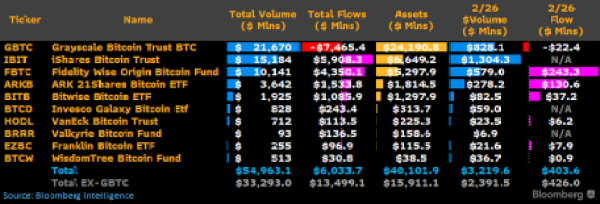
Other funds, including the Franklin Bitcoin ETF, VanEck Bitcoin Trust, and the WisdomTree Bitcoin Fund, all saw minor inflows of $7.9 million, $6.2 million, and $0.9 million, respectively. In total, the inflows to all six funds came out to $426 million.
However, the Grayscale Bitcoin Trust (GBTC) continues to bleed during this time, with outflows of $22.4 million in the 24-hour period. This brought the total net flows to $403.6 million. At the same time, funds such as the iShares Bitcoin Trust, the Invesco Galaxy Bitcoin ETF, and The Valkyrie Bitcoin Fund all saw negligible inflows during this time frame.
Gunning For A New Record
The inflows into the Bitcoin Spot ETFs over the last day are a testament to the demand that these products are getting from the market. With institutional investors gaining more exposure to BitBTCcoin, demand is expected to rise, especially as the BTC price continues to do well.
The inflow volumes, while not the largest single-day inflows so far, are significant when measured up to others. For example, Seyffart points out that the daily record was from the first day of trading when inflows climbed as high as $655 million. The second-largest single-day net flow was then recorded earlier in the month on February 13 with $631 million. “A big day from $IBIT could push us beyond that Day 1 record,” Seyffart declared.
At the time of writing, the BTC price is experiencing a retracement after reaching a new 2-year high of $57,000. It has seen 8.58% gains in the last 24 hours to trade at $55.900, according to data from CoinMarketCap.
Bitcoin Spot ETF Jitters Subside: Grayscale Outflows Drop To New Lows
Outflows from Grayscale’s Bitcoin Trust (GBTC) seem to be slowing down, as shown by the trading activity of Bitcoin ETFs. This comes as investor anxiety over Grayscale’s Spot ETF seems to finally be subsiding, with the entire ETF cohort continuing to attract huge trading volumes and rapid growth in assets under management. As a result, the GBTC saw daily outflows drop steadily over the course of the week to just $44.2 million on Friday, the lowest since spot Bitcoin ETFs went live.
Outflows Drop As Grayscale’s BTC ETF Stabilizes
After several weeks of elevated outflows totaling over $7.44 billion, investors pulled just $436.2 million of Grayscale’s Bitcoin Trust last week. Notably, the lowest daily outflow of $44.2 million came on the last day of the week.
Grayscale’s GBTC is undoubtedly the biggest Bitcoin ETF among its cohort. This is because GBTC was launched in 2013 as a Bitcoin trust available only in OTC markets., allowing it to grow over the years as it was the only go-to for investors looking to dive into the crypto industry.
However, after a lengthy regulatory procedure, the SEC finally approved GBTC’s conversion into a Spot Bitcoin ETF. Consequently, Grayscale’s new Bitcoin ETF went live on January 11, along with nine other recently approved ETFs.
GBTC held around $27 billion worth of BTC assets when it first began trading as an exchange-traded fund (ETF). Surprisingly, Grayscale’s conversion into an ETF came along with a vast amount of withdrawals from investors, and by the end of January, GBTC had witnessed $5.55 billion worth of withdrawals.
Many analysts have attributed Grayscale’s high management fees (1.5%) to the outflows. During this period, other Bitcoin ETFs continued to attract new money. BlackRock’s iShares Bitcoin Trust (IBIT) now has over $6.64 billion worth of BTC in its ETF, followed by the Fidelity Wise Origin Bitcoin Fund (FBTC) with $4.73 billion.
What’s Next For Grayscale’s Bitcoin ETF?
While last week’s outflow data is an encouraging sign for Grayscale and the wider ETF market, outflows could continue in the coming weeks. Bankrupt crypto lending firm Genesis recently received court approval to sell its $1.3 billion worth of GBTC in order to repay its creditors.
The prospect of a liquidation of such gravity has propelled concerns amongst investors of the potential downward implications on the price of BTC. However, many others remain optimistic. According to a report by crypto exchange Coinbase, full liquidation would have a neutral impact on the market as the majority of funds are expected to remain in the crypto ecosystem.
At the time of writing, Bitcoin was trading at $51,300, while Grayscale’s GBTC now had $22.7 billion worth of assets under management.
Analyst: Bitcoin Has Never Been This Bullish, What’s Next?
While Bitcoin treads water around $50,000, with some predicting a slump, one analyst on X is swimming against the current, claiming the coin has “never been this bullish.” The coin is bullish despite cooling off from 2024 highs above $54,000.
Analyst: Bitcoin Is Bullish, Here’s Why
The analyst Mags argues that Bitcoin is, at spot rates, defying historical patterns and showing bullish signals, especially looking at the candlestick arrangements. Specifically, Bitcoin recently closed a weekly candle above the 0.618 Fibonacci level before the next halving event. Mags said this is the first time in the four-year cycle.
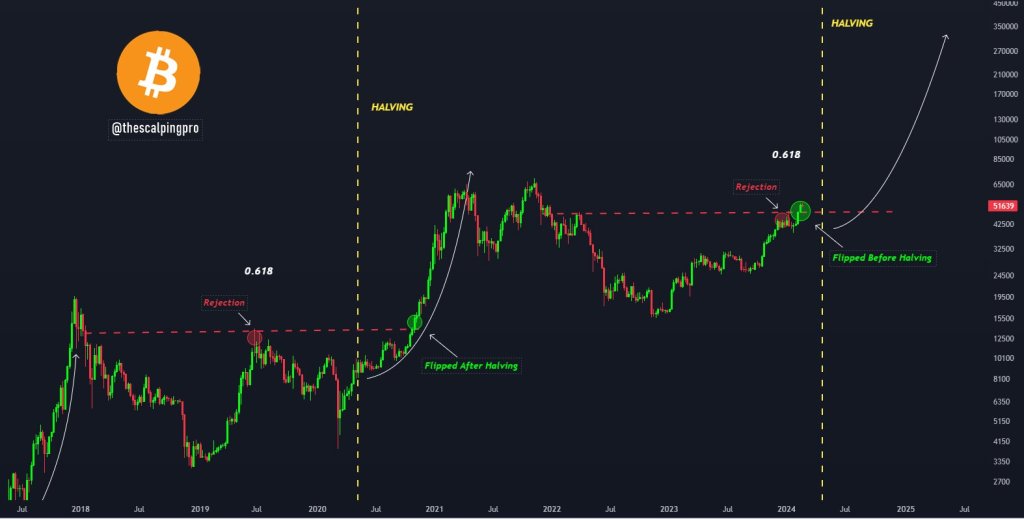
Therefore, though Bitcoin prices have been moving horizontally in the past few trading days, with fears of price slumps, the development in the weekly chart is overly bullish. Further bolstering their optimism, Mags points to the increasing demand for Bitcoin from institutional investors following the launch of spot Bitcoin exchange-traded funds (ETFs).
Wall Street heavyweights, including Fidelity, issue some of these products. BitMEX Research data shows that spot ETFs continue to siphon more and more coins from circulating supply, sending them to custodians, like Coinbase Custody, for safekeeping. These coins will likely be released in the coming years, not months.
Besides institutional interest, optimism for more price gains also stems from the absence of retail interest at spot rates. Data from Coinbase shows that unlike the spike in interest that drove Bitcoin to $70,000, mainly at the back of retailers, BTC prices are up, but the dynamics are changing.
Will Retailers Take BTC To New Levels?
Solid data reveals that retailers are mostly not interested in the coin at spot rates, looking at the amount retailers have been spending on the coin. By Q4 2021, retailers acquiring Bitcoin via Coinbase spent roughly $177 billion. However, this figure sharply fell throughout 2022 during the bear market, finding support in H2 2023.
Then, according to exchange data shared by Will Clemente on X, retailers began loading the coin from Q3 2023. The figure has risen to around $39 billion in Q1 2024–less than 25% of Q4 2021 volumes.
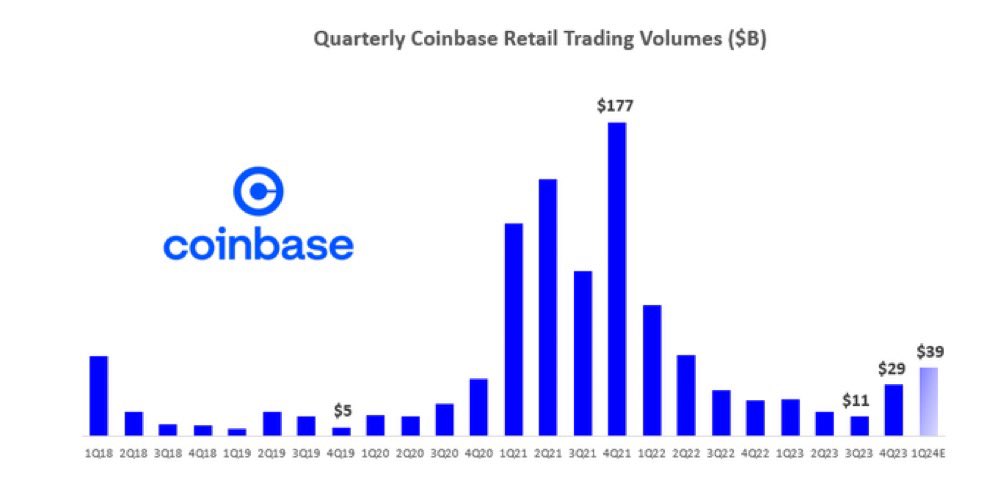
How retailers will impact the price of Bitcoin in the future is yet to be seen. In the past, retail fear of missing out (FOMO) has been a critical price driver. Presently, CoinStats sentiment tracker, Fear & Greed indicator, stands at 74, at “greed” territory, down from “extreme greed” on February 22.
This reduction could be possible because of the fake breakout that lifted Bitcoin above $53,000. The coin has support at $50,500 but generally remains in a bullish pattern.
Australians More Likely to Invest in Spot Bitcoin ETFs After U.S. Approval: Study
The U.S. approval of spot bitcoin exchange-traded funds (ETFs) appears to have had a significant positive impact on the view Australians hold of both cryptocurrencies and bitcoin.
Australians More Likely to Invest in Spot Bitcoin ETFs After U.S. Approval: Study
The U.S. approval of spot bitcoin exchange-traded funds (ETFs) appears to have had a significant positive impact on the view Australians hold of both cryptocurrencies and bitcoin.
Bitcoin Spot ETFs: Issuers Set New Record As Weekly Inflows Cross $2.2 Billion
Bitcoin spot exchange-traded funds have been online in the US for only two months, but their performance has far eclipsed any other asset class. These ETFs recently hit a new milestone, drawing over $2.2 billion in inflows last week alone, shattering the previous weekly record set on the first week of trading. This is a particularly noteworthy development because, as senior Bloomberg analyst Eric Balchunas pointed out, this inflow skyrocketed past the 3,400 plus ETFs available in the US, like the SPLG US and the SPY US.
Bitcoin ETF Inflows Surge Amid Competition
Bitcoin ETFs have fully captured the interest of institutional investors, with trading volume indicating their appealing nature. Trading volume statistics reveal these 10 ETFS have been experiencing a great deal of activity since their launch, netting more than $2.3 billion last week alone to bring the total inflow to $4.926 billion since they went live. As pointed out by Eric Balchunas, the significant inflow last week puts the ETFs above more established ETFs in the United States.
The 10 bitcoin ETFs netted +$2.3b last week. For context, that is more than any other ETF (out of 3,400) took in. $IBIT alone was #2. This brings total net to +$5b, which is more than BlackRock as a whole has taken in. Again, this is all net GBTC bleed. Throw that out and the… https://t.co/PlxnfQ7ETf pic.twitter.com/04LTixd3Zt
— Eric Balchunas (@EricBalchunas) February 17, 2024
Notably, most of this inflow went into BlackRock’s iShares Bitcoin Trust (IBIT), which has outperformed the nine other Bitcoin ETFs and ETFs of other asset classes. IBIT accumulated $1.673 billion in net inflows throughout the week, making it the third-largest inflow among any of the 3,500 plus exchange-traded funds.
At the close of last week’s trading session, BlackRock’s IBIT has received a $5.2 billion net inflow since its launch. Notably, this amounts to 50% of the investment company’s net inflow of $10.4 billion from its 417 ETFs since the beginning of the year.
It’s important to note that these staggering inflow numbers have come amidst an ongoing outflow from the Grayscale Bitcoin Trust ETF (GBTC). While outflows from the ETFs have slowed down compared to recent weeks, the GBTC witnessed $624 million in outflows during the week. “Again, this is all net GBTC bleed,” Balchunas noted.
BTC Bullish Price Momentum Set To Continue
Bitcoin’s price has skyrocketed over 33% in the past 30 days, recently topping $52,000 per coin for the first time since 2021. Current price action shows Bitcoin has somehow stabilized around this price point, with the crypto trading between $52,700 and $50,700 in the past five days. At the time of writing, Bitcoin is trading at $52,307.
However, the fear of missing out on further gains is driving many new investors to Bitcoin ETFs. According to an analyst, inflows into these ETFs are on track to reach $150 billion by the end of 2025. With a new all-time high now looking plausible, Bitcoin is set to continue on its price gain as spot ETF trading commences throughout the week.